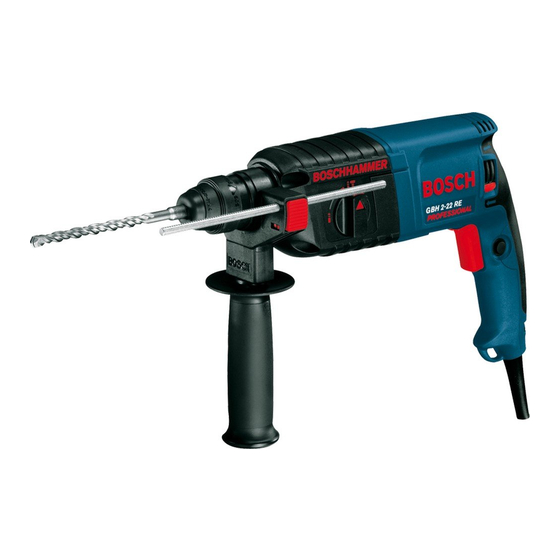Bosch GBH 2-22 RE PROFESSIONAL Оригінальна інструкція з експлуатації - Сторінка 9
Переглянути онлайн або завантажити pdf Оригінальна інструкція з експлуатації для Дриль. Bosch GBH 2-22 RE PROFESSIONAL. Bosch GBH 2-22 RE PROFESSIONAL 46 сторінок. Professional
Також для Bosch GBH 2-22 RE PROFESSIONAL: Інструкція з експлуатації Посібник з експлуатації (50 сторінок), Оригінальна інструкція з експлуатації (9 сторінок)

OBJ_BUCH-795-004.book Page 9 Friday, August 23, 2013 12:16 PM
A damaged dust protection cap should be changed im-
mediately. We recommend having this carried out by
an after-sales service.
Inserting SDS-plus Drilling Tools (see figure D)
The SDS-plus drill chuck allows for simple and convenient
changing of drilling tools without the use of additional tools.
– Clean and lightly grease the shank end of the tool.
– Insert the tool in a twisting manner into the tool holder until
it latches itself.
– Check the latching by pulling the tool.
As a requirement of the system, the SDS-plus drilling tool can
move freely. This causes a certain radial run-out at no-load,
which has no effect on the accuracy of the drill hole, as the
drill bit centres itself upon drilling.
Removing SDS-plus Drilling Tools (see figure E)
– Push back the locking sleeve 3 and remove the tool.
Inserting Drilling Tools without SDS-plus
Note: Do not use tools without SDS-plus for hammer drilling!
Tools without SDS-plus and their drill chucks are damaged by
hammer drilling.
– Insert a key type drill chuck 15 (see "Changing the Key
Type Drill Chuck", page 8).
– Open the key type drill chuck 15 by turning until the tool
can be inserted. Insert the tool.
– Insert the chuck key into the corresponding holes of the
key type drill chuck 15 and clamp the tool uniformly.
– Set the selector switch 9 to the "Drilling" symbol.
Removing Drilling Tools without SDS-plus
– Turn the sleeve of the key type drill chuck 15 with the drill
chuck key in anticlockwise direction until the drilling tool
can be removed.
Dust Extraction with the Dust Extraction Attach-
ment (Accessory)
Dusts from materials such as lead-containing coatings,
some wood types, minerals and metal can be harmful to
one's health. Touching or breathing-in the dusts can cause
allergic reactions and/or lead to respiratory infections of
the user or bystanders.
Certain dusts, such as oak or beech dust, are considered
as carcinogenic, especially in connection with wood-treat-
ment additives (chromate, wood preservative). Materials
containing asbestos may only be worked by specialists.
– As far as possible, use a dust extraction system suita-
ble for the material.
– Provide for good ventilation of the working place.
– It is recommended to wear a P2 filter-class respirator.
Observe the relevant regulations in your country for the
materials to be worked.
Prevent dust accumulation at the workplace. Dusts can
easily ignite.
Mounting the Dust Extraction Attachment (see figure F)
For dust extraction, the dust extraction attachment (accesso-
ry) is required. When drilling, the dust extraction attachment
Bosch Power Tools
retracts so that the attachment head is always close to the
surface at the drill hole.
– Press the button for depth stop adjustment 10 and remove
the depth stop 11. Press button 10 again and insert the
dust extraction attachment into the auxiliary handle 12
from the front.
– Connect an extraction hose (diameter 19 mm, accessory)
to the extraction sleeve 17 of the dust extraction attach-
ment.
The vacuum cleaner must be suitable for the material being
worked.
When vacuuming dry dust that is especially detrimental to
health or carcinogenic, use a special vacuum cleaner.
Adjusting the Drilling Depth on the Dust Extraction At-
tachment (see figure G)
The required drilling depth X can also be adjusted when the
dust extraction attachment is mounted.
– Insert the SDS-plus drilling tool to the stop into the
SDS-plus tool holder 1. Otherwise, the movability of the
SDS-plus drilling tool can lead to incorrect adjustment of
the drilling depth.
– Loosen the wing bolt 21 on the dust extraction attach-
ment.
– Without switching the power tool on, apply it firmly to the
drilling location. The SDS-plus drilling tool must face
against the surface.
– Position the guide pipe 22 of the dust extraction attach-
ment in its holding fixture in such a manner that the head of
the dust extraction attachment faces against the surface to
be drilled. Do not slide the guide pipe 22 further over the
telescopic pipe 20 of the dust extraction attachment than
required, so that as much as possible of the scale 20 on the
telescopic pipe remains visible.
– Retighten the wing bolt 21 again. Loosen the clamping
screw 18 on the depth stop of the dust extraction attach-
ment.
– Move the depth stop 19 on the telescopic pipe 20 in such
a manner that the clearance X shown in the figure corre-
sponds with the required drilling depth.
– Tighten the clamping screw 18 in this position.
Operation
Starting Operation
Observe correct mains voltage! The voltage of the pow-
er source must agree with the voltage specified on the
nameplate of the machine. Power tools marked with
230 V can also be operated with 220 V.
Never use the machine with a damaged cable. Do not
touch the damaged cable and pull the mains plug when
the cable is damaged while working. Damaged cables in-
crease the risk of an electric shock.
English | 9
1 619 P11 523 | (23.8.13)
